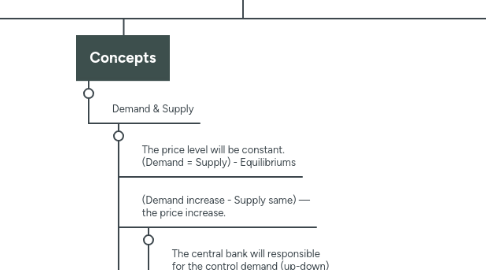
1. DIFFERENCE Between two PI’S
1.1. The BASE YEAR is different for both
1.2. The SERVICES is only present in CPI
1.3. The WEIGHTAGE FOR FOOD ITEMS is different
2. Meaning
2.1. Persistent increases
2.2. It is not increase in price levels
3. Theory
3.1. Central bank is the incharge of controlling inflation.
3.2. Inflation data is released MONTHLY general of previous month of 2 consecutive years - (2018-2017)
3.3. It included group of items with certain weightage signs given for them.
4. Related CONCEPTS
4.1. Deflation
4.1.1. It is opposite to the inflation/ persistent decrease in general price level.
4.1.2. It is very rarely in india
4.1.3. Especially scene in developed countries
4.2. Disinflation
4.2.1. If the inflation is coming down BUT NOT below the NEGATIVE.
4.3. Reflation
4.3.1. When the general price level go below the NEGATIVE the it is known as reflation.
4.3.2. the govt deliberately INCREASE the price levels.
4.3.3. So that the people are forced to consume money so that there will be demand so the PRICE LEVELS will increase.
4.4. Stagflation
4.4.1. It is the phenomenon of BOTH STAGNATION & INFLATION.
4.4.2. This is the REJECTED theory of Philips curve.
4.4.3. It is combined of STAGNATION (Decrease in GROWTH) results in HIGH UNEMPLOYMENT & at the same time HIGH INFLATION.
4.5. Philips curve
4.5.1. Showing the relation between the rate INFLATION & UNEMPLOYMENT.
4.5.2. When the INFLATION is HIGH there will be HIGH EMPLOYMENT.
4.5.3. WHEN an ECONOMY GROW that results in INFLATION & also EMPLOYMENT.
4.6. HEADLINE INFLATION
4.6.1. It is CPI COMBINED (CPI (Rural) + CPI (Urban) & WPI
4.7. CORE INFLATION
4.7.1. They remove the volen items (FOOD & FUEL) from the normal Inflation data.
5. Concepts
5.1. Demand & Supply
5.1.1. The price level will be constant. (Demand = Supply) - Equilibriums
5.1.2. (Demand increase - Supply same) — the price increase.
5.1.2.1. The central bank will responsible for the control demand (up-down) in the country. THROUGH MONETARY POLICY.
5.1.2.2. If increase in price level the RBI will INCREASE the interest rate through the policy rate - it effect the industry’s becoz of INCREASE in IRATE.
5.1.3. (Demand Decrease - Supply same) — the price Decrease.
5.1.4. (Demand same - Supply Increase) — the price Decrease.
5.1.5. (Demand same - Supply Decrease) — the price Increase.
5.1.5.1. The central GOVT is to see the supply factor by FISCAL POLICY.
6. How to measure Inflations in India?
6.1. INDEX
6.1.1. A specialised AVERAGE of some items & they show the RELATIVE change (by compromising the 2 reports) in Price.
6.2. BASE YEAR
6.2.1. Is nothing but the govt takes the normal year prices.
6.2.2. It has to be the NORMAL YEAR (shouldn’t contain any abnormal changes)
6.2.3. Mainly used to CONSTRUCT PRICE INDEX.
6.2.4. PRICE INDEX = (CURRENT YEAR PRICE/BASE YEAR PRICE)
6.3. BASE EFFECT
6.3.1. The (high or low) PREVIOUS YEAR PRICE INDEX can influence the CURRENT RATE OF INFLATION.
6.3.2. Happened in 2013
6.4. PRICE INDEX
6.4.1. Measures the price level (INFLATION)
6.4.2. RBI while to control inflation they recently changed to look into CPI data from WPI data.
6.4.3. CONSUMER PRICE INDEX (CPI) / Retail Inflation
6.4.3.1. Base year = 2012
6.4.3.2. It is not calculated w.r.t FY only calculated w.r.t NY (1st jan - 31st dec)
6.4.3.3. We NEVER seen a deflationary trend.
6.4.3.4. Price index calculated for GOODS & SERVICES are measured.
6.4.3.4.1. Food, beverages & tobacco (will be having generally high weightage) - 49.7
6.4.3.4.2. Fuel & light - 9.5
6.4.3.4.3. Others - 40.8
6.4.3.5. It is the calculated based on CONSUMPTION EXPENDITURE SURVEY by CSO.
6.4.3.6. TYPES OF CPI’s
6.4.3.6.1. CPI (Rural) + CPI (Urban) = CPI COMBINE
6.4.3.6.2. CPI - IW
6.4.3.6.3. CPI - AL
6.4.4. WHOLESALE PRICE INDEX (WPI) / Wholesale Inflation
6.4.4.1. Base year = 2004 - 05
6.4.4.2. Released by The DEPARTMENT OF INDUSTRY POLICY & PROMOTION (DIPP) under Mo commerce’s & Industry on MONTHLY Basis.
6.4.4.3. It calculates GOODS only
6.4.4.4. There will occur deflationary in some times.
6.4.4.5. It gives weightage of GOODS / COMMODITIES they are
6.4.4.5.1. Primary articles
6.4.4.5.2. Fuel & Power
6.4.4.5.3. Manufactured products
6.5. INFLATION RATE
6.5.1. if we want know the INFLATION RATE OF CURRENT YEAR =((CURRENT year price index - PREVIOUS year price index)/Previous year PI)X 100
7. EFFECTS OF INFLATION
7.1. The PURCHASING POWER of the money DECREASES.
7.2. The REAL RETURN varies LOSE TO CREDIT - BENEFITS TO DEBTS
7.3. CREIDTOR
7.3.1. Who gives LOAN.
7.3.2. DEFLATION benefits
7.3.3. INFLATION HIGH - CREDITOR LOOSES
7.3.4. Eg. Banks, NBFC, Bond Holder
7.4. DEBITOR
7.4.1. Who takes LOAN.
7.4.2. INFLATION benefits
7.4.3. INFLATION HIGH - DEBITED BENEFITTED.
7.4.4. Eg. Borrowers, Bond Issuers

